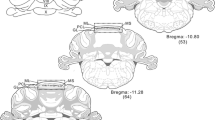Abstract
Previous work in our laboratory has shown that the aziridinium ion of BM 123 (N-[4(2-chloroethylmethylamino)-2-butynyl]-2 pyrrolidone) is a potent and selective muscarinic agonist and binds irreversibly to muscarinic receptors (mAChR). The present series of experiments was designed to study the effects of BM 123 on behavioral and physiological variables known to be sensitive to manipulations of the cholinergic neurotransmitter system. BM 123 was injected into the tail vein of Sprague-Dawley rats, reducing mAChR to approximately 10% of normal as judged by [3H](−)QNB binding. Oxotremorine was injected IV for purposes of comparison. Behavioral and physiological variables were measured daily for 26 days. Physiological variables (e.g., tremor, chromodacryorrhea, salivation, and temperature) showed effects in less than 5 min after injection and returned to their pretreatment baselines within minutes. Nociceptive thresholds, dependent on sensory-perceptual processes, showed peak changes of approximately +230% and returned to normal within hours. Motoric responses, i.e., drinking and general activity, recovered in 3–4 days. Learned responses and those requiring temporal discrimination took 8–11 days to recover and were the only responses paralleling the return of the mAChRs to their normal levels. Changes elicited by oxotremorine recovered more rapidly than those elicited by BM 123. The results suggest that the different variables measured are dependent on different densities of functional receptors. Implications for a theoretical model are discussed.
Similar content being viewed by others
References
Chippendale TJ, Zawolkow GA, Russell RW, Overstreet DH (1972) Tolerance to low acetylcholinesterase levels: modification of behavior without acute behavioral change. Psychopharmacology 26:127–139
Cho AK, Haslett WL, Jenden DJ (1962) The peripheral actions of oxotremorine, a metabolite of tremorine. J Pharmacol Exp Ther 138:249–257
Crocker AD, Russell RW (1984) The up-and-down method for the determination of nociceptive thresholds in rats. Pharmacol Biochem Behav 21:133–136
Ehlert FJ, Jenden DJ (1985a) The binding of a 2-chloroethylamine derivative of oxotremorine (BM 123) to muscarinic receptors in the rat cerebral cortex. Mol Pharmacol 28:107–119
Ehlert FJ, Jenden DJ (1985b) Alkylating derivatives of oxotremorine have irreversible actions on muscarinic receptors. In: Hanin I (ed) Dynamics of cholinergic function. Plenum Press, New York
Ehlert FJ, Jenden DJ, Ringdahl B (1984) An alkylating derivative of oxotremorine interacts irreversibly with the muscarinic receptor. Lift Sci 34:985–991
Fisher AE, Coury JN (1962) Cholinergic tracing of a central neural circuit underlying the thirst drive. Science 138:691–693
George R, Haslett WL, Jenden DJ (1962) The central action of a metabolite of tremorine. Life Sci 8:361–363
Lowry OH, Rosebrough NJ, Farr AJ, Randall RJ (1951) Protein measurement with the Folin phenal reagent. J Biol Chem 193:265–275
Overstreet DH, Yamamura HI (1979) Receptor alteration and drug tolerance. Life Sci 25:1865–1878
Ringdahl B, Resul B, Ehlert FJ, Jenden DJ, Dahlbom R (1984) The conversion of 2-chloroalkylamine analogues of oxotremorine to aziridinium ions and their interactions with muscarinic receptors in the guinea pig ileum. Mol Pharmacol 26:170–179
Russell RW (1966) Biochemical substrates of behavior. In: Russell RW (ed) Frontiers in physiological psychology. Academic Press, New York, pp 185–246
Russell RW (1982) Cholinergic system in behavior: the research for mechanisms of action. Ann Rev Pharmacol Toxiol 22:435–463
Russell RW, Crocker AD, Booth RA, Jenden DJ (1986) Behavioral and physiological effects of an aziridinium analog of oxotremorine (BM 130). Psychopharmacology 88:24–32
Scheffe H (1953) A method for judging all contrasts in the analysis of variance. Biometrika 40:87–104
Schiller GD (1979) Reduced binding of 3H-quinuclidinyl benzilate associated with chronically low acetycholinesterase activity. Life Sci 24:1149–1154
Stephenson RP (1956) A modification of receptor theory. Br J Pharmacol 11:379–393
Yamamura HI, Snyder SH (1974) Muscarinic cholinergic binding in rat brain. Proc Nat Acad Soc 71:1725–1729
Author information
Authors and Affiliations
Rights and permissions
About this article
Cite this article
Russell, R.W., Smith, C.A., Booth, R.A. et al. Behavioral and physiological effects associated with changes in muscarinic receptors following administration of an irreversible cholinergic agonist (BM 123). Psychopharmacology 90, 308–315 (1986). https://doi.org/10.1007/BF00179182
Received:
Revised:
Issue Date:
DOI: https://doi.org/10.1007/BF00179182




